Professional Talks
➜From Data to Diagnosis – Advancing Medical Imaging with Curated Dataset and AI Algorithms.
Stanford MedAI, 2025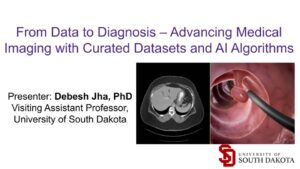
In this talk, I shared how we tackle diagnostic challenges in medical imaging, like data scarcity and bias, through curated datasets and advanced segmentation models. We developed diverse datasets (CirrMRI600+, PolypGen, Kvasir-SEG) and architectures (ResUNet++, ColonSegNet, TransNetR) to enhance diagnostic precision. By aligning deep learning with clinical needs, our approach enables generalizable, AI-powered solutions that support radiologists and improve outcomes across radiology, GI endoscopy, and video capsule diagnostics. The session closed with an optimistic view of how technology can make healthcare more accessible for everyone.
➜Explainable Transformers and Mamba Models for Medical Image Interpretation
IIT Delhi, 2025
I had the honor of presenting “Explainable Transformers and Mamba Models for Medical Image Interpretation” at the FDP on Explainable AI in Healthcare, organized by IIT Roorkee & UPES. I shared insights on transformer-based models, real-world radiology applications, and challenges in building trustworthy clinical AI, with engaging discussions on ethical, transparent AI in medicine. The talk highlighted the importance of explainability for building trust among clinicians. We also explored how AI tools must align with human decision-making processes. Attendees left with new perspectives on designing models that are both powerful and accountable in clinical practice.
➜Revealing the Unseen: Deep Learning for Clinically Silent Patterns in Radiology
MNIT Jaipur, 2025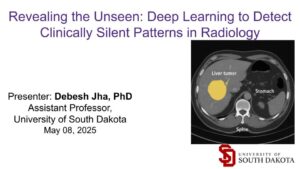
I discussed how AI can uncover hidden anomalies in radiological images, particularly in liver tumors and complex abdominal cases. The session highlighted deep learning’s ability to detect subtle, clinically silent patterns, strengthening early diagnosis and decision-making. We looked at case studies where AI flagged small but significant patterns missed in manual review. These findings sparked conversations about how machine learning can complement human expertise. The talk concluded with ideas for improving patient outcomes through earlier, more accurate detection.
➜Reducing Miss Rates in GI Endoscopy: A Data-Centric AI Approach
MNIT Jaipur, 2025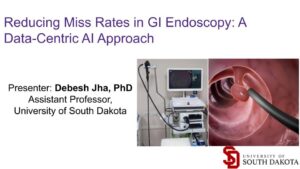
I presented how curated datasets and strong benchmarking play a crucial role in detecting overlooked GI pathologies. Emphasizing deep learning, the talk focused on minimizing miss rates through data-centric AI strategies that enhance reliability and clinical relevance. We examined how cleaner, larger datasets lead to models that doctors can actually trust. I also shared ongoing research on reducing false negatives in clinical trials. This sparked discussions about integrating AI-based checks into existing hospital workflows.
➜Beyond Human Vision: Transforming Radiology and GI Endoscopy with AI
USD Brown Bag, 2024
I explored how AI is revolutionizing radiology and GI endoscopy by enhancing diagnostic accuracy and efficiency through advanced deep learning for detection, segmentation, and classification, while addressing interpretability and adoption in clinical practice. We discussed how AI can act as a “second pair of eyes” for clinicians, reducing fatigue-related errors. I highlighted ethical considerations such as patient privacy and algorithmic fairness. The conversation emphasized the balance between technology and human judgment in life-critical decisions.
➜Transforming Medical AI: Advancing Deep Learning for Precision Diagnosis & Image Segmentation
CUNY CSI, 2024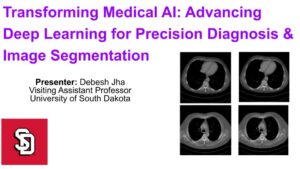
I shared research on AI-driven advances in medical imaging, introducing models like TransNetR and SynergyNet, diffusion-based methods, and datasets such as CirrMRI600+ and PanSegData, highlighting applications from polyp detection to surgical tool tracking. We looked at how hybrid approaches outperform single-model solutions. The discussion also touched on collaboration across radiology departments worldwide. Participants appreciated real-world demos showing how segmentation can improve treatment planning.
➜Biopsy Free Early Detection of Liver Diseases Using AI
Northwestern Radiology, 2023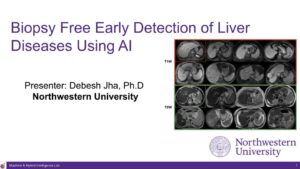
I presented AI-based alternatives to invasive liver biopsies using deep learning to detect cirrhosis, fibrosis, and HCC from scans, introducing CirrMRI600+ and segmentation models like SynergyNet and PVTFormer to improve diagnosis and accessibility. We explored how this approach could make screening less painful and more affordable. The session included examples of how radiology teams integrate these systems in their daily workflows. Attendees were excited about reducing unnecessary procedures and improving patient comfort.
➜The Future is Here: Deep Learning Algorithms Can Reduce the Miss-Rate in Colonoscopy
MIPG Seminar 42, 2022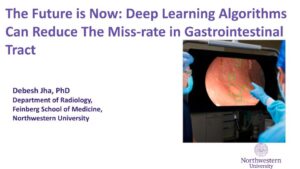
I discussed how deep learning enhances polyp detection and reduces miss rates in colonoscopy with CADe/CADx systems, exploring domain adaptation, multi-center datasets, interpretability, robustness, and regulatory challenges for clinical integration. We examined real-world use cases where AI helped catch lesions that might have been overlooked. The talk stressed the importance of clinical validation before deployment. Doctors and researchers discussed how AI could be seamlessly integrated into endoscopy suites.
➜Khwopa to Northwestern: My PhD Journey and Some Personal Reflections
Khwopa Engg. College, 2022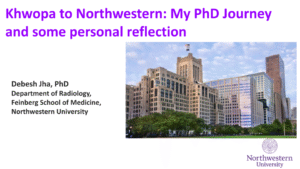
I reflected on my journey from Khwopa Engineering College to Northwestern University, sharing lessons from perseverance, mentorship, and interdisciplinary research in medical imaging that shaped my growth into a recognized researcher. The audience connected with stories of overcoming early struggles. I shared how mentorship shaped my confidence and research outlook. The session encouraged young students to pursue ambitious paths, even when resources are limited.